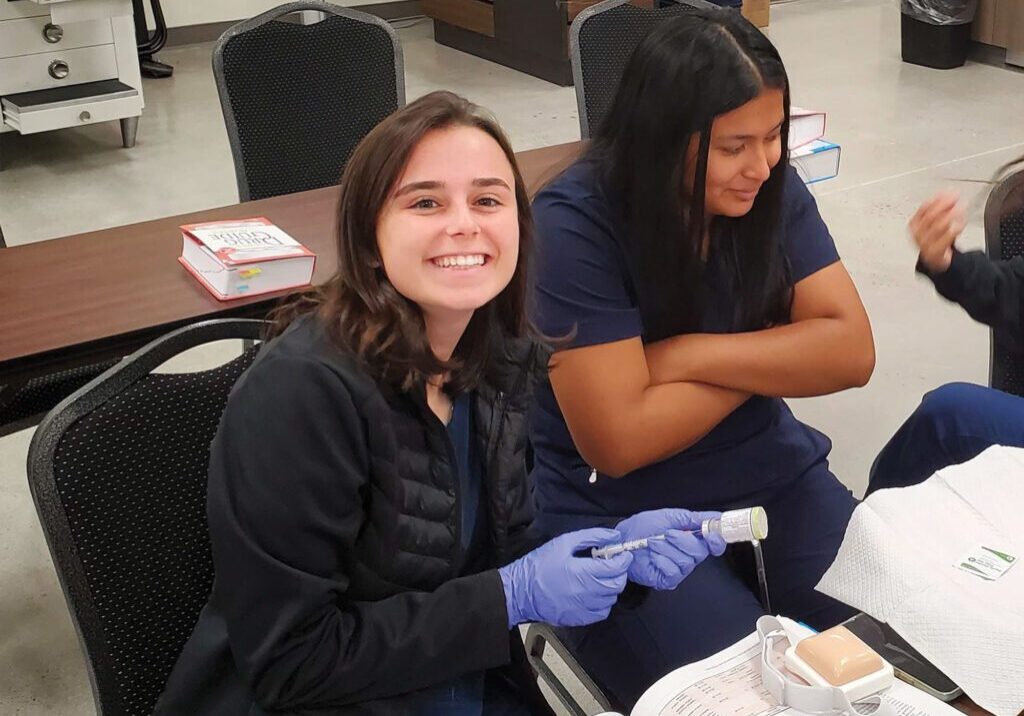“Our American culture wants each generation to be better than the last,” says Tracy Lokstadt, president of The Trade School at Shasta Builders Exchange, a non-profit trade school in Redding, CA.
Unfortunately, Tracy observes, Americans tend to view a college degree as the only pathway to social improvement. A closer look, however, reveals trade careers provide alternate routes to success and financial stability.
Trade careers require practical, skills-based training rather than a university degree. Trades include a wide range of careers, from construction, to healthcare, to agriculture, and beyond — all with histories of benefitting and building society.
“Looking back,” Tracy muses, “I could have gone to trade school to operate heavy equipment, like a bulldozer, and made more money than I do now with my university degree.”

Students with trade school certifications can start earning from day one, while avoiding the huge debt many college graduates face.
NSP spoke with Tracy and three other administrators overseeing career technical education programs to find the truth about this education-to-career option. The reality is clear: for teenage children preparing for life after high school, a trade school can save time and money and lay the foundation for a personally satisfying and financially fruitful career.
Myth #1 — university degrees mean more money
“The industry is having a hard time finding skilled laborers in all sectors,” explains Don Robinson, the dean of welding, construction, advanced manufacturing and automotive at Butte College in Oroville, CA. “It is a bidding war, and if you have the skillset you can pretty much name your price. An entry-level welder can get $50 an hour.”
Tracy agrees, saying, “The national average for an electrical journeyman is $28.87 an hour, plus benefits, and they might make $60,000-$70,000 a year with additional certifications.”
Some trade certifications take as little as one day to complete and “stackable” credentials let students add expertise while working. “Begin with a one day of flagging training,” Tracy says, “and start working. After two years, you can be a journeyman. Stacking a basic traffic controller certification on top moves you to the next level. After that there is a traffic supervisor certification. This is a career pathway in traffic control.”
In addition to earning from day one, trade students avoid the crushing debt many university students graduate with. “Even if you do have to take out loans for a community college diploma, which is really rare, it’s not going to be hundreds of thousands of dollars,” explains Denise Adams, dean of public safety and health programs at Butte College. “And as a reminder, you can go to Butte College for free if you’re taking 12 units.”
Of course, not all entry-level positions command top dollar, but Don knows graduates “who spent way less than a doctor” — both financially and in the time spent on education — “and are easily pulling in a quarter of a million dollars a year after being in the industry for three to five years.”
Myth #2 — People go to trade schools because they aren’t smart enough to get into universities
The misconception that tradespeople are less intelligent than university students has crept into common belief. “Tradespeople are very intelligent people,” Tracy says. “A carpenter, for example, has to know higher levels of math, safety codes, and building codes. Many of our students are off-the-charts intelligent.”
Denise says, “I hear parents say their children need a college education or a bachelor’s degree, so they have to go to a university,” Denise says. “We’re not saying that’s completely off the table.”
She explains how attending a trade school gives students time to gain maturity and experience before committing to an expensive and time-consuming degree. With basic construction training under their belts, for example, students can work and make money while discovering niche industry interests with clear career paths, such as construction management or concrete management.
“When they’re making money and their boss is encouraging them to get further education, they start seeing the value of that,” Denise says, noting that gaining career experience can optimize and motivate a university experience by giving students clear goals toward practical career options.
“I think we have to broaden our perception of what success is,” Denise adds. “Not everyone is on a university track right this minute, but that doesn’t mean they’re not going to get there someday, or that they’re not going to be successful in a career, making a ton of money, enjoying life, and being active participants in our society.”
Myth #3: Trades are mostly backbreaking manual labor, without intellectual stimulation or creativity
Zachary Zweigle oversees a number of career technical education programs at Shasta College in Redding, CA. “With programs ranging from nursing to natural resources, water treatment to welding, and early childhood education to environmental horticulture, students can direct their passions and put their skills, creativity and intellect to use,” Zachary says.
Tracy explains how trades are the real-life application of STEAM (Science, Technology, Engineering, Arts, and Mathematics). “Tradespeople are often very artistic,” she says. “Even the electricians can be really creative and make everything look elegant. You can tell by looking at an electrical box who took pride in their work.” And most trades also rely on workers’ creativity and problem-solving. “The people who really shine are those who can troubleshoot and figure out solutions,” Tracy says.
Troubleshooting and problem-solving often come in the form of new technologies. For example, Shasta and Butte Colleges are both working to offer drone programs. With wildfires repeatedly threatening communities throughout the North State and beyond, drones have gained extra value. Zachary calls drone technology a “skills multiplier,” explaining that drone operation can enhance many of Shasta College’s programs.
“The fire department uses drone footage maps to do tree surveys, figure out where the fire lines are, measure soil moisture, and track hot spots,” Zachary says. “Drones are also used by our criminal justice folks for all manner of policing.”
As these programs develop, youths who have spent endless hours controlling video game characters in virtual worlds may find themselves transferring those skills and interests over to controlling drones in the real world.
Myth #4: Trades are relics of the past.
The pandemic helped illuminate the enduring value of the trades. When business was reduced to “essential” jobs, Tracy points out, “We got stuck in the house, but the HVAC guy was essential. I think we all realized how very essential the people who do service work are to our comfort and living.”
Other trades — like healthcare, roadwork, electric work, welding and plumbing — also remained operational during lockdowns because of their critical roles in the health, functioning and safety of society. Plumbers, for example, monitor contaminate levels in our water systems. “If those systems aren’t working to keep clean water coming in, we have a lot of problems,” Tracy says. As a slogan of the Plumbing Heating Cooling Contractors association expresses: “Plumbers protect the health of the nation.”
Labor shortages and growing needs in the North State mean many of the trades are primed to receive a new generation of employees, opening up careers for young workers.
About four years ago, for instance, Shasta College identified a real need for skilled loggers. “The current generations of loggers are retiring, and there is a lack of skilled workforce in the pipeline,” Zachary explains. “In the wake of recent large scale wildfires, initiatives are being established to strategically manage our forests. Shasta College, in conjunction with CAL FIRE, offers a modern mechanized logging program so the next generation of loggers can lead sustainable forestry management. This will help create a more resilient landscape and reduce the risk of catastrophic fires.”
Within a single semester, Shasta’s logging students learn to operate several $400,000 machines that harvest, process and load timber. They can even receive training to earn their Class-A driver’s license so they can haul equipment to the forest.
“If I were starting my career at this moment, I would definitely be looking at the forest sector because there are jobs here in the North State and there are plenty of companies looking for operators,” Zachary says.
Many other trades are also evolving with the times. Shasta and Butte Colleges both offer computer information systems so students can learn everything from database management to computer network creation. Shasta College is also working on a cloud computing course that Zachary calls “the wave of the future.”
How to start exploring trade careers
If the idea of a trade school appeals to your family, take advantage of trade electives at your child’s secondary school. Make an appointment with a career counselor at a non-profit trade school or community college, and encourage your child to communicate with the counselor about what courses he or she most enjoys. A career counselor can guide students into career pathways with related courses, expanding your child’s awareness of opportunities.
For example, Zachary says, “If they don’t want to be the timber operator, they can become a forester who writes harvest plans, understands the different tree species in the forest, and understands the environmental laws that govern the timber operation.”
Individuals interested in construction without the manual labor might enjoy putting their technology skills into 3D drafting. A techie might not love computer programming, but might discover an interest in building cyber security platforms.
“You want your foundation to be straight when you have someone lay foundation for your house,” Denise says, “and that requires a special skillset. I really hope we can get to a point where we see value in all of the jobs and things people are doing, because we need them all.”
The options are nearly endless, and, because they require fewer years and fewer dollars, students can feel free to explore. There’s a place for everyone.
Each of these trade schools offers multiple programs. Those listed here have especially high employment potential in the North State and beyond.
The Trade School at SBE
• Carpentry
• Plumbing
Shasta College
• Heavy Equipment and Logging Operations
• Agriculture, Horticulture, and Natural Resources
• Early Childhood Education
• Automotive, Diesel Technology, Machining, and Welding
• Business, Accounting, and Computer Information Systems
• Administration of Justice, EMS, and Fire Technology
Butte College
• Certified Nursing Assistant
• Cyber security
• Drafting
• Agriculture
• Diesel Tech
New resources at Butte and Shasta Colleges
The new Butte College Glenn County center in Orland will provide prerequisites such as anatomy, biology and chemistry for health occupations programs including Certified Nursing Assistant and Licensed Vocational Nurse. The center will also offer agriculture courses.
Shasta College has likewise expanded student resources and programs at its Tehama campus in Red Bluff. Weaverville and Burney locations also offer coursework leading to certificates and transfer degrees.
Posted in: Education
Comment Policy: All viewpoints are welcome, but comments should remain relevant. Personal attacks, profanity, and aggressive behavior are not allowed. No spam, advertising, or promoting of products/services. Please, only use your real name and limit the amount of links submitted in your comment.
You Might Also Like...

A Gateway to Health Care: Glenn County Medical Assistant Program Is a Game-Changer
Health care careers are more than jobs—they’re opportunities to make a difference. As health care continues to be a cornerstone of our communities, the need for skilled professionals is more […]

Exchange Students In The North State Share Their Favorite Holiday Food Traditions
Special foods are a sign of the holidays all over the world, and for seven students who are spending this Christmas in the North State far from their home countries, […]

Closing the Gender STEM Gap
Chico’s American Association of University Women Supports STEM Education *Science, Technology, Engineering, and Math education (STEM) The path to women’s economic empowerment and independence is through education. Michelle Obama is […]

Learning Blossoms In School Gardens Throughout the North State
In recent years, school garden programs have become a widespread movement to bring education outdoors and promote hands-on learning for children. Through community collaboration, gardens are blooming on elementary campuses […]






